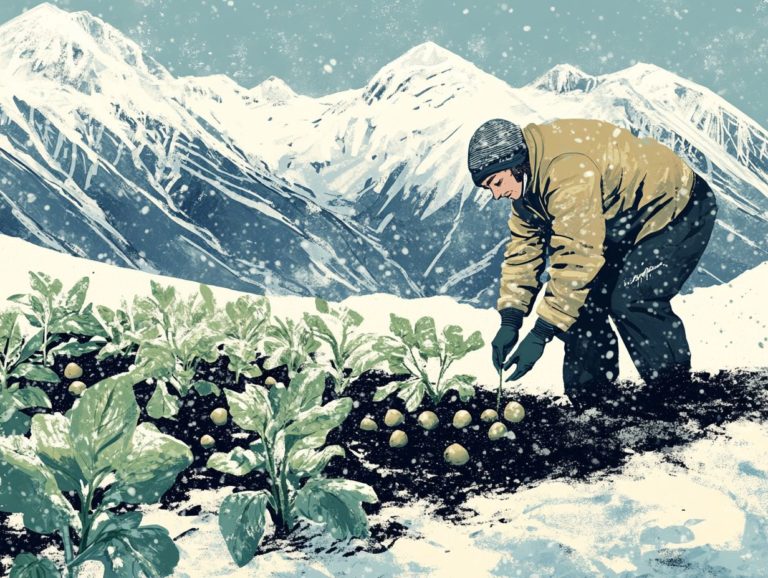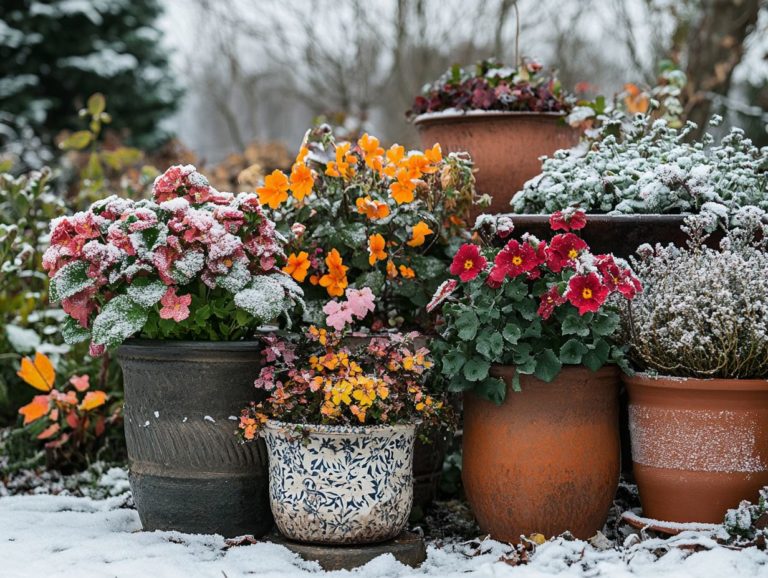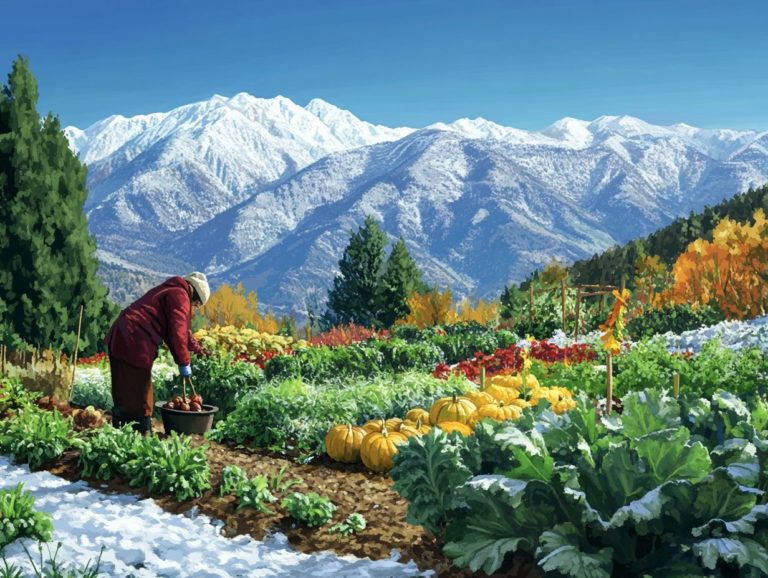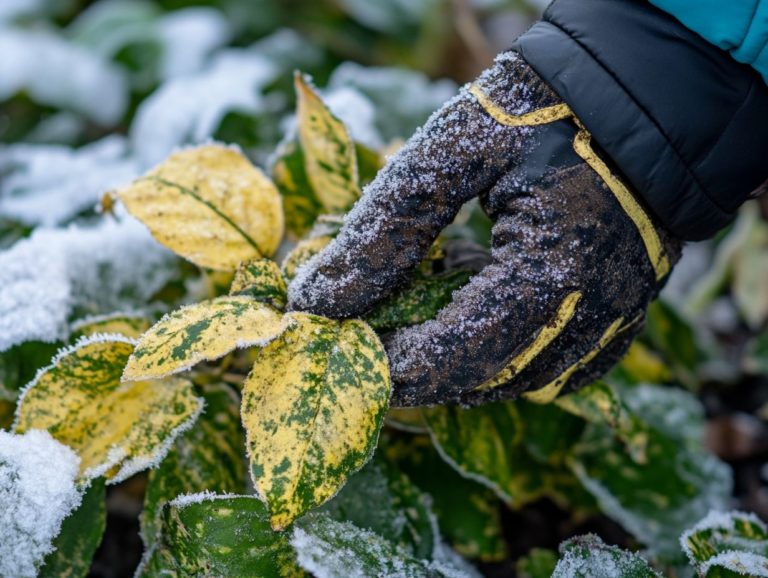What Techniques Help with Pollination in Cold Weather?
Pollination can be delicate, especially when temperatures drop. It s crucial to understand how temperature affects this vital process since colder months make it hard for plants to attract pollinators.
This guide shares natural strategies to boost your pollination efforts. You’ll learn effective planting techniques and how to attract beneficial insects like native bees and butterflies. We ll also cover artificial methods such as hand pollination and innovative indoor solutions.
You’ll find tips to protect your plants from frost while maximizing pollination efficiency. Whether you’re a seasoned gardener or a new enthusiast, this information will help you thrive even in chilly conditions!
Contents
Key Takeaways:

Understanding Pollination in Cold Weather
Understanding pollination during winter is essential for gardeners and conservationists. Many pollinators become inactive in the colder months.
Pollinators like bees and butterflies are key to maintaining biodiversity. Each species has unique ways to survive the cold, often entering an inactive state until warmer weather returns.
By creating habitats with leaf litter and offering nectar-rich flowers, you can enhance pollination efforts in autumn and beyond. This will support a thriving garden ecosystem.
How Temperature Affects Pollination
Temperature significantly influences pollination. It affects the activity levels of pollinators like bees and butterflies and determines when flowers bloom.
During winter, many native bees go inactive. Other species, such as Monarchs, may slow down, impacting the entire ecosystem that relies on them. Unpredictable temperature changes can disrupt the emergence of these pollinators and the timing of flower blooming, creating potential mismatches.
To adapt, choose a variety of native plants that bloom at different times. This will provide food for pollinators throughout the growing season, helping to offset climate-related shifts.
Natural Techniques for Pollination in Cold Weather
Using natural techniques for pollination in cold weather can improve survival rates for vital pollinators like bees and butterflies.
This proactive approach keeps your garden ecosystem vibrant and flourishing, even in winter!
Planting Strategies and Timing
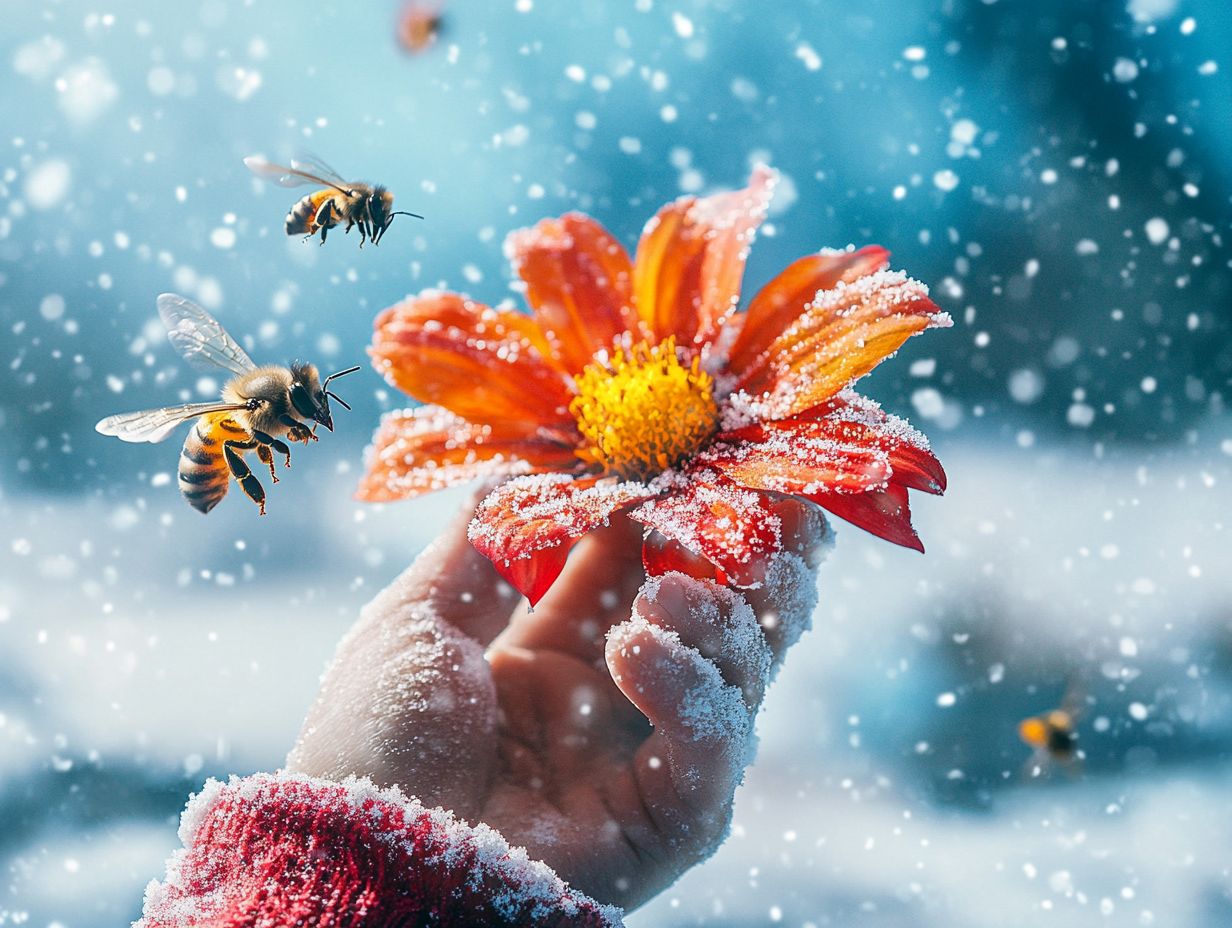
Effective planting strategies and timing are essential for ensuring that pollinators discover ample nectar sources during winter. Specific flowers bloom to support their survival, especially after the nectar dearth in fall.
By thoughtfully selecting flowers that have lots of nectar and flourish in late autumn and early spring, you can create a sanctuary for these vital creatures. This enhances their food sources during cold weather. Implementing staggered planting times guarantees that there are always blooms available. This sustains not only the local bee population but also attracts butterflies and other beneficial insects.
This holistic approach fosters biodiversity and strengthens the ecosystem, making it critical for anyone eager to support wildlife, including crucial pollinators like solitary bees and other beneficial insects!
By planning a diverse planting schedule, you can provide essential resources for pollinators, cultivating a thriving garden that harmonizes with nature throughout all seasons.
Attracting Pollinators
Attracting pollinators to your garden is all about crafting a welcome habitat brimming with diverse flowers that serve as essential nectar and pollen sources for beneficial insects, such as native bees and butterflies.
Incorporating an array of plants that bloom at different times throughout the growing season ensures a consistent supply of food for these vital creatures. From the early blooms of spring to the vibrant displays of late summer, a delightful mix of colors and fragrances will entice various pollinator species, each with its own unique preferences.
Choosing native plant species greatly enhances your garden’s appeal, as these plants are well-suited to your local wildlife, especially the pollinators that rely on them for survival. It’s equally crucial to minimize or completely avoid insecticides, which can harm pollinator health. By doing so, you create a thriving ecosystem where these essential insects can truly flourish!
Keep Your Plants Thriving: Artificial Pollination Techniques in Cold Weather!
You can turn to artificial techniques for pollination during cold weather, such as hand pollination and indoor pollination methods, to ensure that your plants achieve successful reproduction even when natural pollinators are dormant.
These approaches offer effective solutions to ensure successful plant reproduction, particularly when natural pollinator activity takes a dip during harsh winter conditions.
Using Hand Pollination
Hand pollination is an effective technique that allows you to manually move pollen from one flower to another to help them reproduce. This is especially crucial when natural pollinators are scarce during the winter months.
By employing this method, you gain control over the reproductive processes of various plant species, significantly enhancing their chances of fruit production. The process typically involves using fine tools such as a small brush or cotton swab to collect pollen from the male anthers and gently dust it onto the stigma of female flowers. Timing is key; it’s best to perform this task in the early morning when the flowers are fully open and most receptive to pollen!
This technique not only improves fruit set but also fosters biodiversity by enabling the cross-pollination of different cultivars, ensuring robust yields even in challenging environments where pollinators are limited.
Indoor Pollination Methods
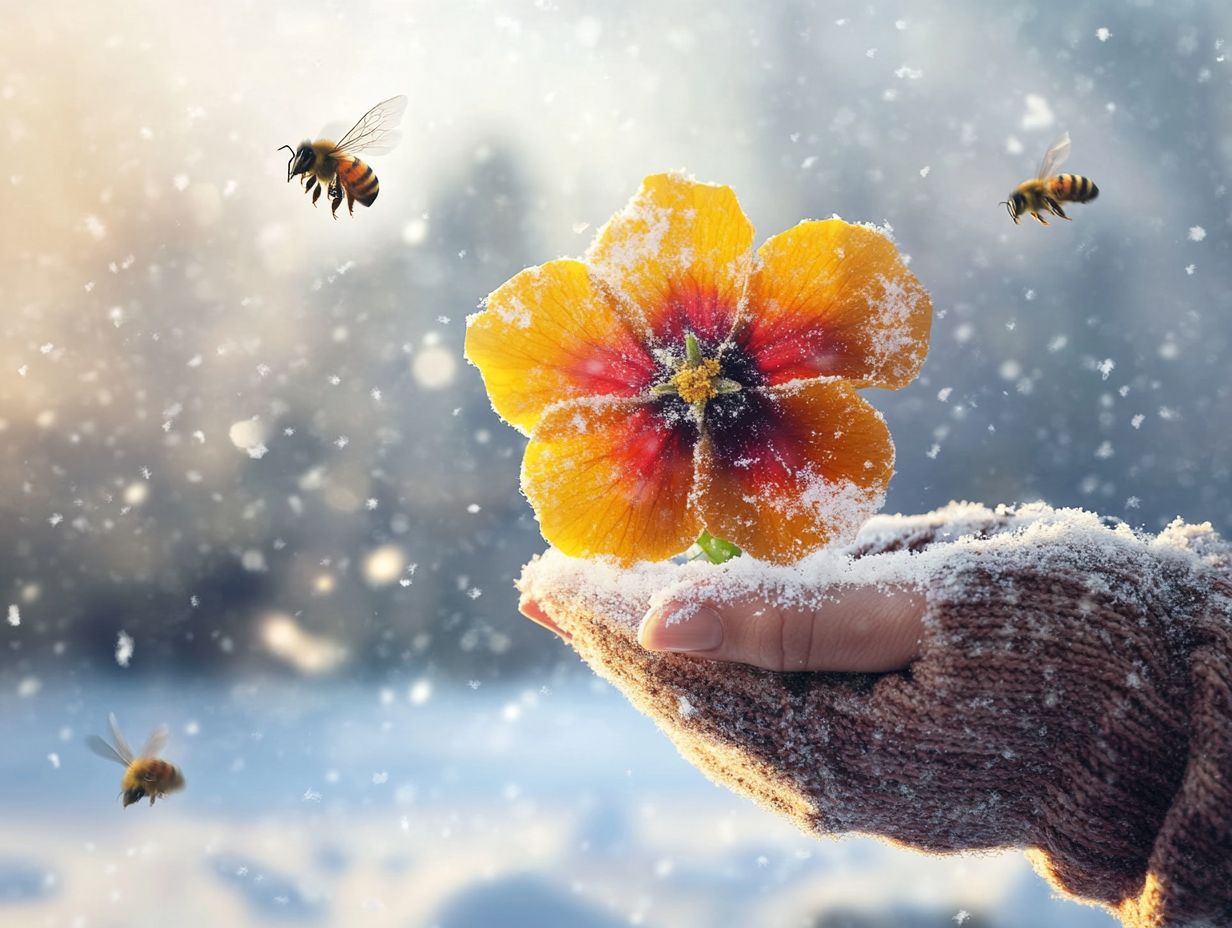
Indoor pollination methods present an invaluable alternative for you as a gardener. They allow you to sustain your plants and promote pollination even when the cold weather disrupts outdoor activities and natural insect interactions, ensuring the survival of all species involved.
By utilizing various techniques like small brushes or cotton swabs you can manually transfer pollen from one flower to another. This ensures that the reproductive process continues seamlessly indoors. It s essential for you to maintain optimal temperature and light conditions, as these elements significantly impact the health of your plants and their ability to reproduce successfully.
A carefully regulated environment fosters strong growth and boosts the effectiveness of your chosen pollination techniques. This ensures your indoor garden flourishes even in less-than-ideal weather.
Tips for Successful Pollination in Cold Weather
By implementing smart strategies for successful pollination in cold weather, you can greatly enhance the chances of plant reproduction. This approach supports the health and survival of beneficial pollinators, ensuring that pollinators thrive even in the face of frost and chilly conditions.
Protecting Plants from Frost
Protecting your plants from frost is essential for their survival. This is especially important for delicate flowers that attract pollinators. Cold weather can damage delicate blooms and disrupt pollinator activity, so taking action is paramount.
To achieve this, you can employ a variety of effective methods tailored to your specific flora. Take into account their habitat needs and the local climate. Insulation techniques, like using burlap or row covers, create a protective barrier against chilling winds and frost while still allowing light and moisture to penetrate.
On particularly cold nights, consider covering your plants with sheets or blankets for that extra layer of warmth. This ensures that both your plants and their pollinator friends are safe.
Selecting plants that withstand frost is another strategic choice. This allows you to cultivate species better equipped to handle low temperatures, ensuring that your garden remains a haven for pollinators.
Understanding how temperature fluctuations impact both your plants and their pollinators is vital. This is especially important during the winter months when pollinators may hibernate.
Maximizing Pollination Efficiency
Maximizing pollination efficiency in cold weather demands a smart approach. This balances the needs of both plants and pollinators, including the necessary food sources and habitats.
By thoughtfully assessing and selecting the best locations for feeder placements, you can create inviting hotspots that attract essential pollinators. This significantly boosts their foraging activities.
Promoting biodiversity, which means having a variety of different plants and animals in your garden, not only guarantees a steady nectar source throughout the growing season but also nurtures a resilient ecosystem capable of weathering fluctuations.
Understanding weather patterns is crucial. Adapting your gardening practices to temperature changes can make a significant difference. Warmer days typically spark increased pollinator activity and elevate overall pollination success.
By implementing these strategies, you will more effectively support the delicate balance of nature in your garden.
Frequently Asked Questions
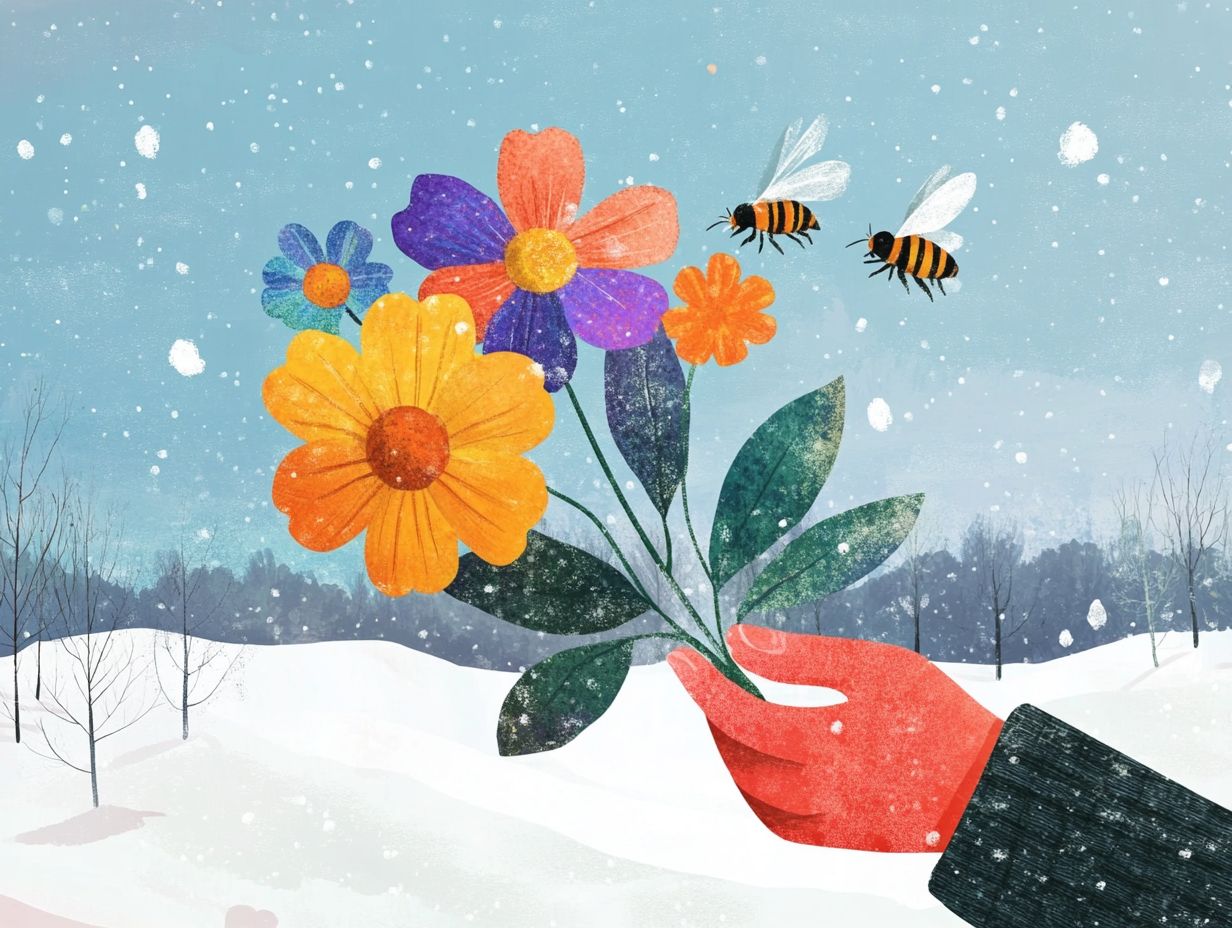
What techniques can help with pollination in cold weather?
Some techniques that can help with pollination in cold weather include hand pollination, using wind or artificial pollinators, and providing shelter for plants.
Act now to protect your plants and keep those valuable pollinators thriving! Try these methods and share your experiences.
How Does Hand Pollination Work in Cold Weather?
Hand pollination means moving pollen from the male parts of one plant to the female parts of another. In cold weather, use a small brush or cotton swab for this task.
Can Wind Aid Pollination in Cold Weather?
Yes! Wind can help pollinate plants during chilly days. Place plants in a breezy spot to encourage pollen transfer between flowers.
What Are Artificial Pollinators?
Artificial pollinators are tools like small vibrating devices or electric toothbrushes. They mimic the movement of insects and assist in pollination when bugs are scarce.
Why Is Providing Shelter Important for Plants?
Cold weather can damage plants and hinder pollination. Create shelter with a greenhouse or cover plants with blankets to protect them from harsh conditions.
Which Plants Thrive in Cold Weather?
Excitingly, some plants like winter squash, pumpkins, and specific berries thrive in colder temperatures. These plants are well-suited for pollination during winter.


